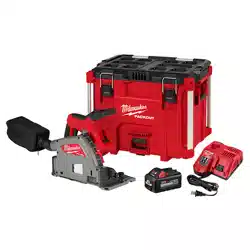Loading ...
Loading ...
Loading ...

13
3. Line up the front/rear blade position indicators
with your cutting line. These show where the
blade will cut when plunged when using a guide
rail.
(A) 1/2"
(B) 3/4"
(C) 1"
(D) Maximum cut depth
D C B A A B C D
4. Position your arms and body to resist Kickback.
5. To start the saw, push the lock-o button down,
then pull the trigger. Allow the motor to reach full
speed before beginning cut.
6. Slowly lower the saw until preset depth is reached.
7. While cutting, keep the shoe flat against the
workpiece and maintain a rm grip. Do not force
the saw through the workpiece. Forcing a saw can
cause Kickback.
8. If making a partial cut, restarting mid-cut or cor-
recting direction, allow the blade to come to a
complete stop. To resume cutting, center the blade
in the kerf, back the saw away from cutting edge
a few inches, push the lock-o button down, pull
the trigger and re-enter the cut slowly.
9. If the saw binds and stalls, maintain a rm grip
and release the trigger immediately. Hold the saw
motionless in the workpiece until the blade comes
to a complete stop.
10. After nishing a cut, release the trigger, be sure
the blade comes to a complete stop and return the
front handle to its upright position before setting
the saw down.
Scoring Cuts
A scoring cut helps prevent splintering of
the workpiece. Use a guide rail when
performing scoring cuts. Make a scoring
cut rst and then make another pass at
normal cut depth. To set the depth of cut
to 1/16" (1.5 mm) for a scoring cut, push the scoring
cut stop forward. To unlock, pull the scoring cut stop
back.
Overloading
Continuous overloading may cause permanent dam-
age to tool or battery pack.
Cutting Masonry and Metal
MILWAUKEE circular saws are not intended for con-
tinuous use in cutting metal or masonry. When cutting
these materials, use the correct blade. MILWAUKEE
does not recommend using bonded abrasive wheels
on circular saws for any application.
WARNING
Dust, chips, and grit can cause
guard to hang up at any time. If saw
is used to cut masonry or metal, reserve and mark
it for that purpose only and return it to a
MILWAUKEE service facility for cleaning and
testing before using it for wood cutting.
Only use accessories with maximum speed rating
at least as high as nameplate RPM of tool.
When cutting masonry, use a diamond blade. Make
successive passes at depths of less than 1/4" to
achieve the desired depth. Cutting at a depth of more
than 1/4" will damage wheel. Remove battery pack
and frequently clean dust from air vents and guards.
WARNING
Do not use tool for cutting metal
near ammable material. Sparks
may cause re.
When cutting metal, use a metal cutting blade. Set
depth of cut to full depth. Protect everyone in the
area from sparks.
Cutting Plastic
When cutting plastic, avoid overheating the blade
and blade teeth to prevent melting the workpiece.
MAINTENANCE
WARNING
To reduce the risk of injury, always
unplug the charger and remove the
battery pack from the charger or tool before
performing any maintenance. Never disassemble
the tool, battery pack or charger. Contact a
MILWAUKEE service facility for ALL repairs.
Maintaining Tool
Keep your tool, battery pack and charger in good
repair by adopting a regular maintenance program.
Inspect your tool for issues such as undue noise,
misalignment or binding of moving parts, breakage of
parts, or any other condition that may aect the tool
operation. Return the tool, battery pack, and charger
to a MILWAUKEE service facility for repair. After six
months to one year, depending on use, return the
tool, battery pack and charger to a MILWAUKEE
service facility for inspection.
If the tool does not start or operate at full power with
a fully charged battery pack, clean the contacts on
the battery pack. If the tool still does not work prop-
erly, return the tool, charger and battery pack, to a
MILWAUKEE service facility for repairs.
WARNING
To reduce the risk of personal in-
jury and damage, never immerse
your tool, battery pack or charger in liquid or
allow a liquid to ow inside them.
Cleaning
Clean dust and debris from any vents. Keep tool
clean, dry and free of oil or grease. Use only mild
soap and a damp cloth to clean, since certain clean-
ing agents and solvents are harmful to plastics and
other insulated parts. Some of these include gasoline,
turpentine, lacquer thinner, paint thinner, chlorinated
cleaning solvents, ammonia and household deter-
gents containing ammonia. Never use ammable or
combustible solvents around tools.
Loading ...
Loading ...
Loading ...
